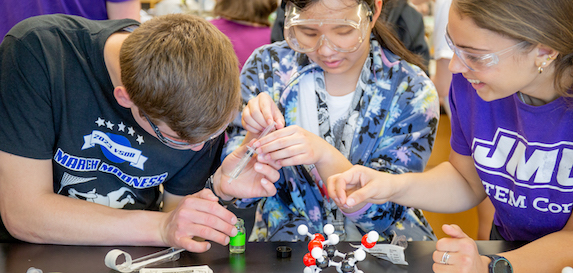
About the Partnership
This partnership started in 2022 and is coordinated by Virginia School for the Deaf and the Blind (VSDB) Science teacher, Mr. Dylan Boeckmann, and STEM Center director, Dr. Kerry Cresawn. Together with JMU student volunteers, VSDB students with visual impairments carry out new or adapted versions of our faculty-developed science and engineering experiences. Lesson designs and facilitator guides for our adapted experiences can be found below.
Our Approach
Our model for making STEM accessible to students with visual impairment (VI) through community outreach challenges standard practices of modifying existing experiences often limited to increasing the size or providing braille transcriptions of text and/or using a directed assistant. We start with faculty-driven learning experiences developed for JMU students as inspiration for novel lessons in which key learning outcomes can be achieved through tactile or auditory analysis. Frequent communication with our partnering teachers of students with VI and constructive feedback from the students is critical to developing experiences that highlight the need and opportunities for VI representation in the STEM community.
Photo Gallery
We are currently adding Alt Text and hope to have this available by May 2024
Experiences
Materials Science for High School Students:
Students tested different organic plasticizers in the synthesis of chitosan-based bioplastics. After the films set, they tested physical properties of the film such as stretch and twist. Because the original investigation developed for JMU Chemistry students already relies on tactile methods of analysis, few modifications were made to the experimental design and learning objectives.
- JMU Feature Story: Building accessible community in the lab
- Lab Investigation and Facilitator Guide:
Engineering Design for Middle School Students:
Students used the engineering design process to build a Rube Goldberg-inspired machine which is a series of chain reaction designed to achieve a goal such as having a ball go through a hoop. Knowing the shape and form of an object is critical when deciding how to incorporate that object into the design. Because shape and form of a 3D object can be understood visually and/or tactiley, there were no modifications made to the available materials and design process. The only modification made was to the final reaction. Instead of getting the ball into a cup, the ball had to hit a percussion instrument providing auditory feedback.
- Design Challenge and Facilitator Guides
- Video: VSDB Students Demonstrating their Rube Goldberg Design
Computer Engineering for High School Students
Using a variety of instrumental sounds and pitches, students turned environmental sensor data into sound. They measured temp., humidity, and light around the building and analyzed sonification of that data to find the optimal location for an indoor garden.
- Facilitator Guide: Coming Soon
- Video: 2-minute clip showing VSDB and JMU Students testing the sensors.
